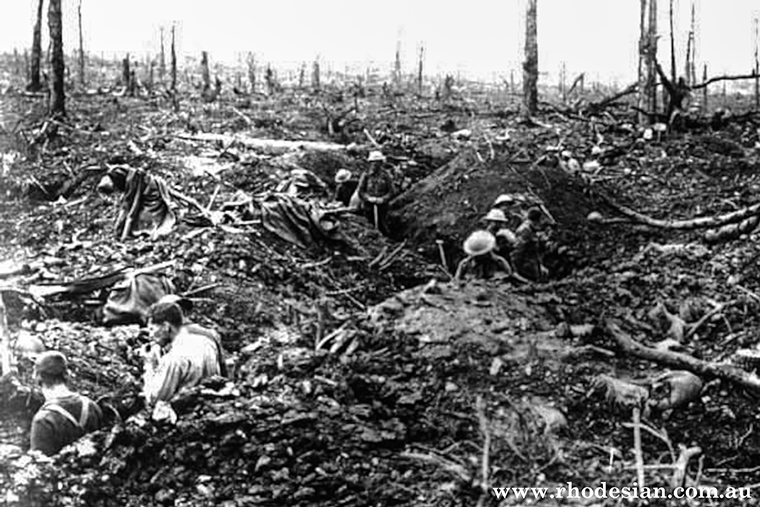Back when I still lived in South Africa, a couple of my jobs required car trips to small towns to check on stores or visit cooperating agencies. Several of these out-of-the-way places happened to be near old battlefields of the Boer War, so I’d try to set aside a day or two to visit them and “touch history” (my shorthand expression for such activities). Over time, I visited Spion Kop, Paardeburg, Ladysmith, Mafeking and Majuba. I also got to see a couple from the earlier Zulu Wars, Isandlwana and Rorke’s Drift (described in the movie Zulu) . I wrote about my trip to the last one years ago, but it’s buried in the archives and if I can find the thing, I’ll re-publish it sometime.
Anyway, one week from today is Memorial Day, and as always, it’s the day I remember my late grandfather Charles Loxton, who fought and was badly wounded at the Battle of Delville Wood in 1916. As the saying goes, it’s “where 25,000 men marched in; and one week later 2,500 marched out.” Here’s Delville Wood now:

..and as my grandfather probably saw it in 1916:

So #4 on my Bucket List is to visit not just Delville Wood, but as many old WWI battlefields as I can. Time permitting, it’s one of the activities I’d like to get done during my upcoming sabbatical in Britishland, because to see most of them would require a trip of only a few days across the Channel.
Mr. Free Market suggests that I do my pilgrimage during late November or early December, “…when the weather is foul and one can appreciate the absolute misery — the cold, the rain and the mud — that the poor infantry had to deal with.”
Sounds like a plan.

Back when I was a Civil War reenactor (Union, before anyone asks) I visited Fort Ward, which was an earthworks fort set up to defend Washington DC. One of the nice things about it was, while it had been preserved pretty well, it wasn’t an actual battle site, so it hadn’t developed the usual battlefield accretions battlefields get (at least in the US), neither good (cemeteries, monuments) or bad (tourist traps, wax museums, Shoney’s). Again, as a reenactor I got to see the conditions under which garrison troops lived.
At the other end of the spectrum lies Gettysburg. While the battlefield is somewhat preserved, and there’s an abundance of monuments and of course the cemetery, there’s also a lot of crap that’s grown up around it. There wasn’t a reenactor (or indeed any Civil War buff) who didn’t cheer when that stupid tower was taken down.
Hope you don’t mind a link to the video of the tower demolition, just because. Note the reenactors with cannon “helping”.
https://www.youtube.com/watch?v=ieQB231ggrE
No great cloud of dust……the ground must have been really soggy.
My grand dad on my mothers side was a WWI vet. He spent most of his time in the army helping build the Russian trans continental rail road. He did spend some time after that in the Philippine’s doing something with a machine gun, but he did not talk about it much.
My Uncle, his son spent some time on ships during WWII with the navy. He later made a career out of the Navy rising to the rank of Master Chief.
I like to visit battle fields as well. the more mundane and hidden the better.
100 years ago this year, my grandfather and his brother were drafted into WW1. Couple of 29 year old Swedish farm boys. The next year would cripple them for the rest of their lives. My grandfather told very few stories about the war, and sadly none to me, I was 12 when he died. Hand to hand with trench knives smelling his foes breakfast on his breath, forward night posts were no one is ever alive in the morning, shelling that goes on and on and you pray to get knocked unconscious so you cant hear or feel it anymore. It started with such high expectations and ended in German hospitals recovering from wounds, mustard gas, and shell shock. On his death bed he kept asking if the war was over, such was the impact even 50 years latter.
My grandfather never held a steady job again, he tried but would inevitably eventually break down. His brother was the same but worse. The VA got him dependent on drugs for pain and stress and he washed it down with alcohol to keep the demons at bay. Today we call it PTSD, then they ignored it for the most part.
He always had a poppy on his cars rear view mirror and as a kid I always laughed about gramps and his obsessions with poppies. I get it now, and Flanders Fields. I went to the local American Legion to buy a couple of poppies this week. Come Memorial day when I bring flowers to my wife, I’m going to epoxy putty poppies to my gran and gramps headstones. I think he would like that.
“Like that”? He’s probably been waiting for YEARS for someone to do that for him…
I learned a lot about the American Civil War at my maternal grandfather’s knee as he recounted stories told to him by his uncles. He never spoke about his own experiences in The Great War. When he passed, he bequeathed to me his World War I diary which I transcribed and posted to my website.
http://www.laroke.com/larryk4674/2001/poppop.htm
Thank you, thank you so much for sharing and it was great the way you kept the original spelling and the diary gives a vivid impression of an enlisted man’s experience putting up with life in a combat zone 100 years ago. In the 1960’s when I was stationed in Germany I visited some of the WWI battle field areas and cemeteries and walked through the depressions in the ground where the trenches were. You could still see where the tops of the trees had been mangled 50 years before.
When I lived in Madang, PNG, I lived on an old Japanese outpost. We used to find corroded ammo clips, Japanese beer bottles, and a few expended .50 slugs.
A few miles offshore was the submerged wreck of a B-25.
Sadly, neither of my Grandfathers really talked about their wartime experiences.
I’m first generation Canadian, my paternal grandfather Fritz fought for the Germans and got machine gunned at Verdun. He got a minor divot in one tit, lost most of the other tit and one bicep. One year in hospital, invalided out.
I’m told it turned him from a serious young man into a fun loving and mildly irresponsible rascal. In my visits there and his here, he always joked that he didn’t hold it against me that Canadians had shot him up, which it wasn’t, I told him, it was die verdammte Französischen.
Anyway, I decided on one trip to see Verdun, where the old boy got shot. It’s just off the road between Frankfurt and Paris. Glad I did. A few old fields preserved with original crump holes. A decent museum. A few old wrecked concrete forts. The highlight though is the Ossuary. A magnificently creepy building housing the bones of at least 130,000 unidentified soldiers from both sides.
[adding that to my list]
Every Memorial Day, I remember two men I never met, but wish I had:
Bugler Howard I. Carroll, my grandfather
117th Trench Mortar Battery, 42nd (Rainbow) Division, WW1, 1917 – 1919
The 117th fired for every infantry regiment in the Rainbow and for other divisions in their sectors at
(1) Luneville sector, Lorraine, February 21 to March 23, 1918;
(2) Baccarat sector, Lorraine, March 31 to June 21, 1918;
(3) Esperance-Souain sector, Champagne, July 4 to July 15, 1918;
(4) Champagne-Marne defensive, July 15 to 17, 1918;
(5) Aisne-Marne offensive July 25 to August 11, 1918;
(6) St. Mihiel offensive, September 12 to 16, 1918;
(7) Essey and Pannes sector, Woevre, September 17 to 30, 1918;
(8) Meuse-Argonne offensive, October 12 to November 1, 1918;
(9) Meuse-Argonne offensive, November 5 to 10, 1918;
They stood before Sedan with the most advanced units of the AEF, and participated in the Rhine Occupation.
Awards: Victory Medal with 5 bars, Occupation Medal, Croix de Guerre
Granddaddy Irvine died after the war from effects of being gassed.
Capt. Donald L. Gambrill, my father’s best friend, best man and my Godfather,
485th Bomb Group (Heavy), WW2
55 missions as B-24 pilot over Germany, Italy, Austria, Romania
Awards: Distinguished Flying Cross, Air Medal with 2 Oak Leaf Clusters, Purple Heart
KIA 10-Apr-45
They shall not grow old, as we that are left grow old:
Age shall not weary them, nor the years condemn.
At the going down of the sun and in the morning
We will remember them.
My grandfather was overseas in France and Germany from Oct 1917 until April 1919. I have his war diary, medals, patches, bugle and trench knife, and recently donated my collection of more than fifty-five unit histories and documents, written by the men of the division who were there, to the George C. Marshall Foundation Library. I read them all multiple times, collected maps, and my bucket list item is to drive from St. Nazaire where he debarked, to the training areas, to the battlefields and towns he passed through, all the way to Bad Neuenahr in Germany where he was an occupation troop. The division left New York with 28,000 men, and sustained nearly 15,000 casualties in nine months of combat.